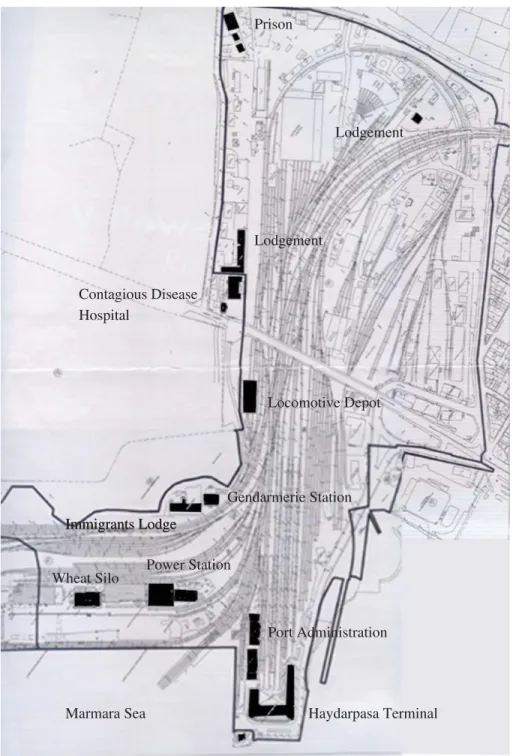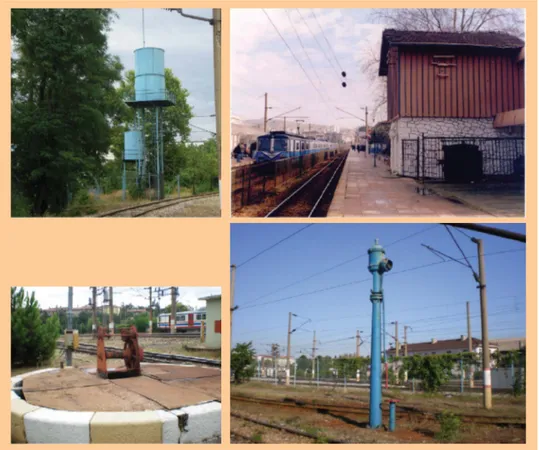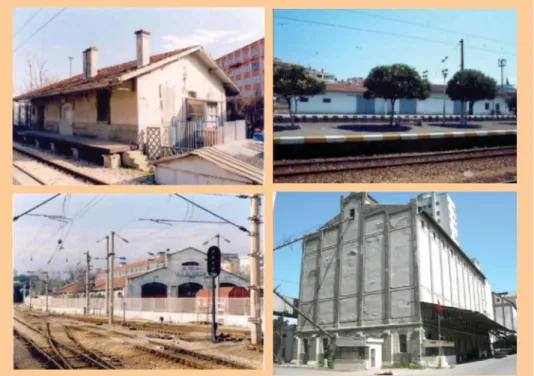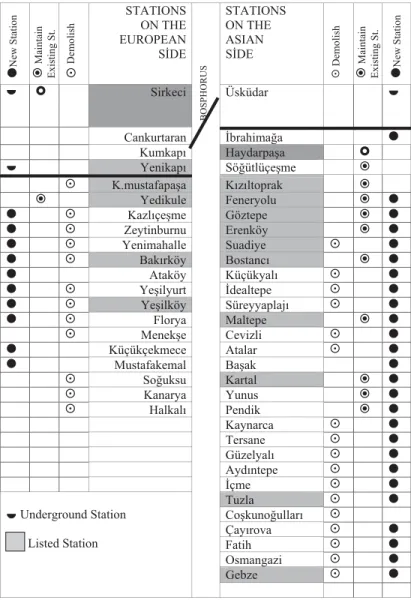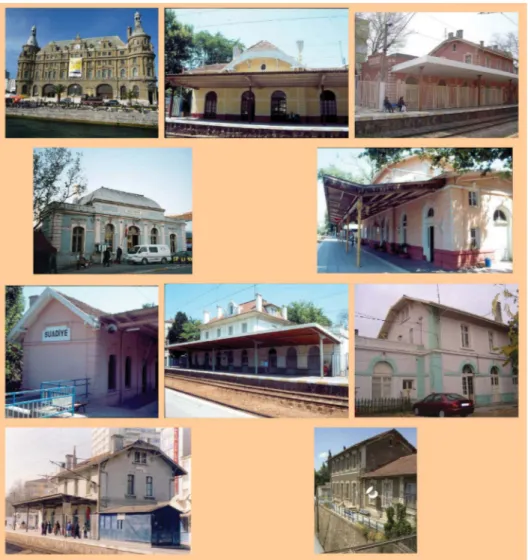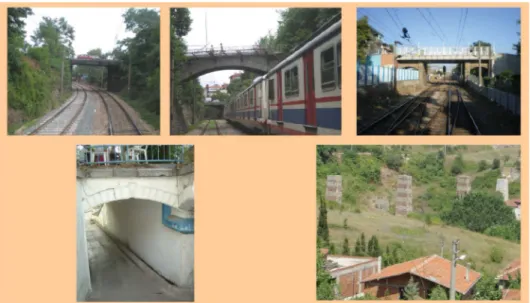Full Terms & Conditions of access and use can be found at
International Journal of Architectural Heritage
Conservation, Analysis, and Restoration
ISSN: 1558-3058 (Print) 1558-3066 (Online) Journal homepage: https://www.tandfonline.com/loi/uarc20
Railway Heritage of Istanbul and the Marmaray
Project
Yonca Kösebay Erkan
To cite this article: Yonca Kösebay Erkan (2012) Railway Heritage of Istanbul and the Marmaray Project, International Journal of Architectural Heritage, 6:1, 86-99, DOI: 10.1080/15583058.2010.506622
To link to this article: https://doi.org/10.1080/15583058.2010.506622
Published online: 03 Oct 2011.
Submit your article to this journal
Article views: 439
View related articles
Copyright © Taylor & Francis Group, LLC ISSN: 1558-3058 print / 1558-3066 online DOI: 10.1080/15583058.2010.506622
RAILWAY HERITAGE OF ISTANBUL AND
THE MARMARAY PROJECT
Yonca Kösebay Erkan
Kadir Has University, Istanbul, Turkey
This study explores the significance of Istanbul’s railway heritage and discusses the criteria for evaluating the historical importance, architectural value, and social issues surrounding the city’s rail system, leading into an examination of the consequences of the Marmaray Project. The Marmaray Project is a commuter rail system designed to unify Istanbul’s two independent rail transportation systems, and it will connect Halkalı on the European side with Gebze on the Asian side of the city. With the beginnings of rail construction in the 1870s, the waters of the Bosphorus separated the Oriental Railway on the European side from the Anatolian and the Baghdad Railway, preventing a direct connection between Europe and Asia. The Marmaray Project will actualize this universal, long desired dream via an under water tunnel. However, the design of the project bears significant risks for the city’s railway heritage dating back to the 19thand 20thcenturies. At risk are structures used by travelers,
lodgings, ateliers, depots, water closets (WC’s), underpasses, retaining walls, bridges and old trees.
KEY WORDS: railway heritage, preservation, listed buildings, Oriental Railway, Anatolian
and Baghdad Railway, Marmaray Project
1. RAILWAY HERITAGE
The concept of Railway Heritage has become an issue of preservation in the past 25 years, first in England and later all around the world. The impetus behind the preser-vation of railways (a relatively new issue) has been linked to their decline; after having reached their peak in popularity after the industrial revolution in the second half of the 19th
century, railways as a means of transportation began to decline in the second half of the 20th
century as the result of the closing down of coal mines, which many of the early railways were built up around. Decaying abandoned railway buildings in England led to increased public consciousness about their heritage, and this in turn resulted in the exhibition “Off the Rails,” part of SAVE Britain’s Heritage in 1977 (Burman 1997). It was only after this moment that the concept of a railway heritage was recorded, preserved and propagated. In 1984 British Rail set up a Railway Heritage Trust and entrusted this organization with the task of protecting this heritage. In 1985, British Rail had 630 listed railway buildings under the Railway Heritage Trust (Biddle 2003); by 1997 this number had increased to 1256 (Soane 1997), and in 2003 rose to 2000. Other than specific buildings, more than
Received October 2, 2009; accepted July 4, 2010.
Address correspondence to Assit. Prof. Dr. Yonca Kösebay Erkan, Graduate Program for the Preservation of Cultural Heritage, Kadir Has University, Kadir Has Avenue 34083 Cibali Istanbul, Turkey. E-mail: yonca.erkan@ khas.edu.tr
50 railway lines were listed as well. These figures are not comparable with the railway buildings that are preserved in Turkey today, and, in addition, not one railway line has been registered as a cultural asset.
In the world, references to railway heritage extend beyond academic circles. Apart from local and national foundations, several web-based groups support and disseminate knowledge on railway heritage.1 Often, parties seeking out their past in the heritage of railways apply for the UNESCO World Heritage List (WHL) in the hopes of having their districts recognized and supported. In order to organize applications for WHL, ICOMOS set up a guideline outlining the criteria for railway heritage applications for WHL (Coulls 1999). In determining nominees, the following criteria are equally considered: the loca-tion’s role in history and its technological and social aspects. For example, in 1998 the Semmering Railway in Austria (1998) and in 1995 and 2000, the Himalayan Mountain Railway (1995; 2005) fulfill the stipulated criteria and have been catalogued in the World Heritage List.
In 1989, UNESCO provided the following definition of cultural heritage in its full scope as:
The cultural heritage may be defined as the entire corpus of material signs - either artis-tic or symbolic - handed on by the past to each culture and, therefore, to the whole of humankind. As a constituent part of the affirmation and enrichment of cultural identi-ties, as a legacy belonging to all humankind, the cultural heritage gives each particular place its recognizable features and is the storehouse of human experience. The preser-vation and the presentation of the cultural heritage are therefore a corner-stone of any cultural property (Jokilehto 2005, p. 4).
When elaborated in terms of railway systems, it is the railway culture (e.g., buildings, equipment, furniture, ephemera) that needs to be passed on to new generations. However, buildings should not be limited to those used by travelers; on the contrary, they should be treated within a broader spectrum including engine depots, ateliers, merchandize depots, water closets (WC’s), bridges, underpasses, tunnels and signal boxes.
2. WHY SHOULD THE RAILWAY HERITAGE OF ISTANBUL BE PRESERVED? 2.1. Historical Importance
The idea of constructing a railway between Istanbul and Belgrade was announced in 1855 in the newspapers. Submission of applications began in 1856 and continued until the concession for construction was granted to Baron Hirsch in 1869 (Engin 1993). Based on this concession, the Oriental Railway Company was established in 1870 and construction began from Yedikule to the Küçükçekmece Line on the European side. This line operated until 1871 on a single track; however, the location of Yedikule was thought to be too distant from the city center and complaints urged the company to build a station at Sirkeci, which would require tearing down the walls of Topkapı Palace. In the following years the Orient Express operated on the Oriental Line, and made its first expedition from Paris in 1888.
1Examples include: the Railway Heritage Trust, the Orville Railroad Heritage Soceity, the Mary Valley
Heritage Railway, the West Coast Railway Association, the Somerset Dorset Railway Heritage Trust, the Seymour Railway Heritage Center, the Donegal Railway Heritage Center, the Festiniog Railway Heritage Group, and the National Railway Historical Society.
To welcome arrivals from Europe, a new monumental building for passengers was built in Sirkeci in 1890. At the time of the construction of the line, the Ottoman Government had agreed to pay 14.00 francs as a guarantee per kilometer, which led Baron Hirsch to become one of the wealthiest notables of Europe while leaving the Ottoman Government in debt.
As a result of this experience, the government decided to build a railway line on the Asian side that would connect Istanbul with inner Anatolia, but by its own means. In this way, following the construction of the Iskenderiye-Cairo, Köstence-Cernavoda, Ruscuk-Varna, Izmir-Aydın and Istanbul-Austria lines, which were built with foreign cap-ital (mainly British), for the first time the Ottoman government financed and commenced the construction of its own railway, the Haydarpa¸sa-Izmit Railway, in 1870 (Öztürk 1995). The aim of this project was to connect Istanbul with Baghdad and it would have branch lines, which would connect to the Black Sea, the Mediterranean and the Basra region. However, construction reached only as far as Pendik, due to technical and financial limita-tions. In 1872, the Ottoman Government looked for foreign know-how and hired Wilhelm von Pressel to prepare a new project, and the line extending to Izmit was completed in 1873. However, the line could not be extended further in to inner Anatolia as was planned, and in 1880 the Haydarpa¸sa-Izmit Railway Line was rented out to a British Group, The Sfeelder & Hanson and Co., for 20 years (Öztürk 1995). In 1888, the contract was can-celled and the right to use the line was handed over to a German Consortium represented by Alfred von Kaulla (Özyüksel 1988). Based on this agreement, the Anatolian Railway Company was established and the line was extended to Ankara in 1892 and to Konya in 1896. In 1898, a further pre-concession was granted to the same company to extend the line to Baghdad. The first implication of this agreement was the granting of another concession to build a new port at Haydarpa¸sa in 1900, which was completed in 1903. Some of the aux-iliary buildings of the port can still be seen at Haydarpa¸sa (Figure 1), such as grain silos, a military police station, and a power station (Erkan 2007). In 1900, the Hejdaz Railway, another initiative of the Ottoman Empire, made departures from Haydarpa¸sa. In 1906 the construction of the new Haydarpa¸sa Station began with the order of Sultan Abdulhamid II, who requested a grandiose building, which would mark the terminal of the Hedjaz Railway (Fındıkgil-Do˘guo˘glu 2002).
The granting of the concession to the Germans drew the ire of countries seeking to colonize new lands, such as England and France; thereafter, global political stability would be thrown off balance in the years to come. During the War of Independence fought by Turkey following the defeat of the Ottoman armies in World War I, the Anatolian Railway played major roles in defending the country. With the founding of the Turkish Republic in 1923, railway construction overlapped with the ideological underpinnings of the modernization movement set into place by the new Turkish government.
2.2. Effects on Urban and Social Life
The construction of the Anatolian Railway not only changed the course of history but the physical appearance of Anatolian urban life as well. Traditional urban fabric grew up around newly constructed railway stations and commercial activity developed around them (Erkan 2007). Around the world, it has been observed that early railways generally did not penetrate city centers but rather passed by at a distance. The same is observed in settlements around the Anatolian Railway, such as in Ankara and Eski¸sehir. This distance resulted in large number of petitions being filed which asked railway stations to be built
Haydarpasa Terminal Power Station Wheat Silo Gendarmerie Station Immigrants Lodge Immigrants Lodge Locomotive Depot Contagious Disease Hospital Lodgement Lodgement Prison Port Administration Marmara Sea
closer to city centers. For example, the Oriental Railway connecting Istanbul with Europe stopped at Yedikule when it was opened in 1871. But it was considered to be too far from the city center and in 1872, based on complaints, the ruling Sultan granted permission for the tearing down of the walls of Topkapı Palace in order to facilitate railway access to Sirkeci station (Erkan 2007. p. 25).
Before the arrival of railways, agricultural techniques used in Ottoman territories were highly traditional. Transportation of goods was troublesome due to an insufficient road network and restricted to caravan trade. The Anatolian Railway provided a good, but not cheap, means of transportation for goods to Istanbul and from there on to Europe. In this way, agricultural surplus increased dramatically and had a positive impact on the econ-omy of the Ottoman Empire (Karkar 1975). The Anatolian Railway Company supported agricultural activity around railways by providing loans and setting up education facilities giving training about scientific agricultural techniques. Thereafter, the agricultural surplus boosted commercial activity; this activity also brought in other services, such as banks and insurance companies. Moreover, this increase in the capacity of trade obliged the direc-tors of the Haydarpa¸sa Railway terminal to expand its port facilities in 1900. There, two large electric grain silos were built, which were considered among the most modern of their time.
From the end of the 19th century until the formation of new Turkish Republic
(1923), the contracting empire relocated the incoming waves of immigrants along the railways. In particular, immigrants from the Balkans, who had expertise in scientific agri-cultural techniques, contributed greatly to agriagri-cultural improvement. Immigrants arriving in Istanbul were registered at special offices, one of which was the Immigrants Lodge built in 1906–1908 at Haydarpa¸sa (Erkan 2007, p. 68). It is known that some of the notables of these immigrant groups were relocated in Istanbul, while many others were directed to newly built villages or quarters in Anatolia, around the larger cities such as Eski¸sehir, Ankara, Kütahya, and Afyon. Many such villages were named after Sultan Abdulhamid II as Hamidie to pay honor to the Sultan. Immigrants were mostly Muslim, yet Jewish groups were also accepted (Erkan 2007, p. 111).
Railway stations as public buildings were new architectural forms for society. Until the middle of the 19thcentury, Ottoman buildings were not specialized for public purposes.
Only after the Tanzimat, a series of administrative reforms made in 1839, specialized pub-lic buildings began to emerge, such as houses of governance. Prior to this date, coffee houses, hans and hamams can be thought of as playing the role of public places, which were generally used by males as places of leisure. Traveling on the other hand was bound to the Sultan’s decree, and when taking into consideration the difficulties of journeys in those years, it is logical to realize that women could not easily travel about. But railways offered women the opportunity to travel. Railway stations with female waiting rooms, the
Haremlique, for female passengers, opened up new venues for women’s public presence.
These remarks on the construction of railways were made in order to stress the historic and social importance of the Oriental and the Anatolian Railway Lines. This historic past is reflected into the present day through the railway buildings and aspects of the railway heritage.
2.3. Architectural Importance
The railway heritage of Istanbul has a past more than one century old (Figure 1). These buildings are products of a highly systematic culture of construction which has
been documented in archival records (Shier 1899).2The Anatolian railway, running from
Haydarpa¸sa to Konya, was constructed in four sections. The first section extends from Haydarpa¸sa to Izmit, the second from Izmit to Ankara, the third from Ankara to Eski¸sehir and the last from Eski¸sehir to Konya. The line from Haydarpa¸sa to Gebze was designed as a commuter line, which continued to Izmit as a regular railway. For the entire Anatolian Railway Line, running from Istanbul to Konya, typological design projects were adopted, arranged according to different classes (e.g., first, second, third) of stations. The railway platform measured approximately 400 m. A passenger building, water tank, well for drink-ing, merchandise depots and worker barracks were typical elements of the station (Erkan 2007, p. 121). Railway buildings were situated parallel to the tracks. Usually passenger buildings were situated alongside urban development. In a typical station the passenger building was designed for passenger services on the ground floor and the upper storey was appropriated for lodging.
In the evolution of railway buildings in Istanbul, several phases parallel their his-torical development. The first passenger buildings were made of wood and looked very much like houses. Not many remain from this group; only one example can still be seen in Göztepe, which is used as housing (Erkan 2007, p. 122). At that time, the city did not extend as far as the stations. Therefore, the buildings around railways had a subur-ban character; for example, passenger buildings had semi-open verandas. During the first decades of the 20thcentury, the suburban character changed to a more urban character, and
this shift can be observed in the design of passenger buildings. Those on the Anatolian line are made of masonry and lack outdoor spaces. Verandas evolved into canopies on the front of the passenger buildings. In contrast, the single-storey passenger buildings on the Oriental Line are located on a central platform and have a steel frame construction. On this route, lodgings were designed independently from the passenger buildings. Until 1915, the railways in Istanbul operated on a single track. Only after then were the lines doubled. The landscape of the stations changed in 1969 when the railway system changed from steam to electricity, and the platforms were adjusted to suit the requirements of this new technology.
In Istanbul, at terminal areas such as Yedikule, Haydarpa¸sa and Sirkeci, are wagon depots, ateliers, merchandise depots, and other structures as part of the railway heritage. However, it is primarily Haydarpa¸sa and the Sirkeci terminal buildings that are of high architectural importance. Their architectural styles highlight the political discourse of the period. The Sirkeci station was the gate opening to the East, and was therefore embellished with oriental elements, whereas the Haydarpa¸sa station was the gate opening to the West and in its design neoclassical influences can be observed.
The protection status of the railway heritage of Istanbul is random, meaning that the buildings have not been not recorded and listed systematically. Included within this her-itage status are the stations that have been registered as cultural assets on the European side, including Bakırköy (registered in 1992), Ye¸silköy (1995), Yedikule (1992), and Sirkeci (1979). On the Asian side, these stations include Haydarpa¸sa (1997), Kızıltoprak, Feneryolu, Suadiye, Bostancı (2004), Göztepe (1988), Erenköy (1979), Maltepe (2005), Kartal (1997) and Gebze (1992). In every station complex, the numbers of listed historic buildings varies. For example, at Ye¸silköy are nine registered buildings, whereas at Sirkeci the entirety of the station complex is under legal protection. These buildings have managed
2At the Turkish National Railway’s archive in Ankara are original numbered drawings belonging to this
to preserve their architectural qualities intact over the years; however, since the millennium, their annual maintenance has been neglected. Above all, however, today the railway her-itage of Istanbul is most at risk due to the implementation of one of the most grandiose civil engineering projects of our era: the Marmaray project.
3. RISKS THREATENING THE RAILWAY HERITAGE OF ISTANBUL 3.1. The Marmaray Project
The Marmaray Project is a commuter rail system that will connect Halkalı on the European side with Gebze on the Asian side via an underwater tunnel crossing the Bosphorus. The line goes underground at Yedikule, continues through Yenikapı and Sirkeci via new underground stations, passes under the Bosphorus, connects to the new Üsküdar underground station and emerges at the surface at Sö˘gütlüçe¸sme (Lykke and Belkaya 2005). The entire system will be 76 km long, 13.4 km of which will be underground. Three underground stations, as well as 37 surface stations (36 of which will be new), an operational control center, yards, workshops and maintenance facilities will be constructed. In the first phase (C1) of the Marmaray Project, the existing double tracks will be removed and three new tracks will be laid (Lykke and Belkaya 2005). New stations will be placed on a central platform creating space for the additional third line. It is assumed that two of the newly laid rails will serve for the intercity transportation as before, and the additional third rail will serve as the main line, that is, for international or national lines. However, it should be noted that the underwater tunnel has the capacity for only two rails, as do the current land tunnels and bridges, for example. Inevitably this capacity means that this new railway project will have destructive effects on existing railway stations and settlements adjacent to the railway line above the ground, thereby threatening the railway heritage. To date, severe consequences have already occurred for archaeological sites in the process of digging tunnels for the system. In the end, the construction of the Marmaray Project will have irreversible negative impacts on and spoil the remains of two historically significant railway lines.
The Marmaray Consortium, due to legal constraints, has agreed to preserve rail-way buildings that are registered. However, this plan leaves a large body of railrail-way heritage outside the scope of protection, such as those in addition to passenger build-ings and lodgments. Structures that reflect the long-lived tradition of the railway such as water tanks, ateliers, merchandise depots, engine depots, bridges, retaining walls and old trees, have not been taken up as an issue of concern (Figures 2 and 3). This project bears several other complications: The Marmaray project will have 37 stations (Table 1). Of these, only one will be reused, and the other 36 will be new constructions. In other words, 18 listed historic stations (Sirkeci, Kumkapı, Yenikapı, Kocamustafapa¸sa, Yedikule, Bakırköy, Ye¸silköy, Haydarpa¸sa, Kızıltoprak, Feneryolu, Göztepe, Erenköy, Suadiye, Bostancı, Maltepe, Kartal, Pendik and Gebze), will be abandoned and lose their original function. Naturally, questions have arisen about their reuse (Figures 4 and 5). The platforms of the current stations as well as the canopies of the passenger buildings will be demolished in order to provide the extra space needed for the new lines (Figure 6). Vibrations caused by the speed of trains will cause further damage to these historical buildings. Sound barrier walls will cover the façade of the historic buildings, which will further isolate the buildings. Along the Marmaray route between Halkalı and Gebze, 182 bridges and underpasses will be demolished. Of these, 28 are historic masonry structures, and only eight are listed as
Figure 2. Photographs of some of the water structures (color figure available online).
a cultural asset (Figure 5). Also, monumental trees planted along the railway and at the stations will be chopped down.
Apart from physical constraints, the project has management problems as well. Double-track passage through the underwater tunnel requires international and cargo trains to use the tunnel only at limited intervals. Marmaray’s connection with high-speed inter-city trains will cause similar management problems. Should the Marmaray Project push out railway transportation from the area, not only will rail transport at Haydarpa¸sa be rel-egated to history, but also its connection with sea transport. There is a possibility that only intercity trains may use Haydarpa¸sa train station. Although this use may seem to be a pos-itive step in terms of continuity of rail transport, it does not seem probable due to technical constraints.
The importance of the Marmaray Project is beyond controversy. Turkish newspapers and media have devoted much time to discussing the project. The archaeological findings that surfaced as a result of drilling and digging, and their importance as agents of change regarding how the history of Istanbul is understood, have been among the topics discussed. Several symposia on the excavations have been held, and scientific papers have been pub-lished about the construction techniques used in construction of the tunnels and how the undersea tunnels were immersed (Lykke and Belkaya 2005). However, the project has not been widely discussed in public as regards new construction work on the ground and their
Figure 3. Photographs of some of the depots (color figure available online).
impacts on existing stations and the urban fabric, with one exception of two small public presentations.
At present, another risk the railway heritage faces are the urban regeneration projects developed by the Municipality of Istanbul. These projects have been designated for several locations in Istanbul, and thus are not specific to the railways. Yet, each of them overlaps with a historic railway center. The Haydarpa¸sa Urban Regeneration Project is an off-shoot of the Marmaray Project. The project focuses on the railway terminal at Haydarpa¸sa (constructed in 1908), on the supposition that the area will be abandoned with the com-mencement of the Marmaray Project. The second is the Kartal Urban Regeneration Project, at the eastern end of Istanbul, and it aims to form a secondary city center, rehabilitating the old stone mines and their surroundings. The historic railway station at Kartal is within the boundaries of this project. The third urban regeneration project is intended for the west end of the city, at Zeytinburnu, where a commercial port is planned to be built in conjunction with the railway.
3.2. Reuse of Haydarpa ¸sa and Sirkeci Railway Terminals
The Haydarpa¸sa and Sirkeci terminals will be bypassed aboveground and the current terminal areas will be subject to new regeneration projects. For the abandoned land, the equivalent of upwards of millions of square meters, new functions have been proposed. The reuse of the Haydarpa¸sa and Sirkeci terminals and their annexes creates massive problems for preservation. In particular, the Haydarpa¸sa terminal adjacent to the harbor is currently considered to be a new development zone. Planning for this area will be managed via a
Table 1. The impact of Marmaray Project on the historic railway stations in Istanbul
new protection plan, which was approved at the end of 2009. According to this plan, the old harbor will be developed as a port for international cruise lines, while the area contain-ing harbor infrastructure, includcontain-ing the railway terminal, will accommodate a mixed-use restructuring. It has been argued that the plan respects the registered historical buildings; however, earlier versions of this plan indicated such wildly inappropriate applications such as high-rise buildings and high-density commercial uses. Starting from the beginning of the 19thcentury, as the encampment and training ground of the army, Haydarpa¸sa developed
into a public zone with the construction of a military hospital, a railway station, and a medical school, for example. One significant aspect of this area is that historically it has been a public area, even before the arrival of the railway. Therefore protection of its public character is essential for collective memory of citizens.
Figure 4. Photographs of some of the historic structures (color figure available online).
Nonetheless, with public and NGO involvement, Haydarpa¸sa was declared a cultural and historic preservation site in 2006. In addition, in the 32nd meeting of UNESCO World Heritage Committee (UNESCO 2008), it is stated:
The central Railway Administration submitted a proposal for development to Protection Board V. The High Court annulled the article of the law giving planning authority for this area to the Central Railway Administration and the Protection Board declared the area an ‘Urban and Historical Site’ on 26th April 2006 and the Supreme Protection Board in Ankara have specified that no developments can be carried out that harms the topography, natural character, silhouette and importance of the site and the proposal prepared by the Central Railway Administration was refused. The Protection Board required that a development plan should be prepared and a protocol was signed between the Central Railways Administration and Istanbul Metropolitan Municipality to give responsibility to the Metropolitan Municipality for preparing a plan which will require the approval of Protection Board.
Figure 5. Photographs of some of the historic bridges (color figure available online). WC Eave Platform Arrival Departure Voyager B. Depot
Figure 6a. Plan of the current situation of the exemplary station.
WC Departure Voyager B. Depot Voyager B. Platform Arrival
The roof of Haydarpa¸sa Station caught fire in late December 2010, which further com-plicated the existing preservation problems there. During the fire extinguishment seawater was poured over the building with ample amount. The damage of the salt over the sand stone façade can be seen with naked eyes. Following heavy rains and couple of water floods due to broken plumbing, the building stepped into a sensitive condition. Soon after, a temporary protective shed has been built over the roof floor. Simultaneously, the Turkish National Railways has begun tendering process for the new roof, where a new function for the previously unused attic storey is desired. Should it be implemented as suggested, it is certainly another way to go around the protection decisions, which demands the building to be preserved as it is.
The Sirkeci terminal area was declared a cultural site, due to its location near Topkapı Palace in 1995. For Sirkeci terminal, it is stipulated that the existing railway will be used as part of the light metro system, and Sirkeci Station will become a museum. However, these mere flashes of ideas have yet to be widely discussed.
The European Union has declared Istanbul the European Cultural Capital of 2010. This nomination, as well as the current political implications, has put great pressure on Istanbul in terms of its global marketing. Urban regeneration projects are used as a tool for this economically driven achievement, along with privatization, support of public lands, and so on. Today, the historic railway buildings in Istanbul are at risk. In many of the current official documents prepared by Turkish National Railways, these buildings are referred to as being worn out, old, difficult and expensive to renew. On the contrary, their structures are sound and suitable for extended use. In general, railway buildings bear great potential for contemporary uses.
4. CONCLUSION
Preservation of the railway heritage comes into discussion whenever buildings are at risk. This has been valid in England and in many other European countries, as it is in Turkey today. It should be noted that public awareness regarding the preservation of Haydarpa¸sa terminal was raised when people realized that they would not be able to use the building as a train station anymore. However, the consciousness for preservation should enlarge its domain and inhabit buildings and equipment for other than monumental value. What is needed is for public initiatives, governmental and/or nongovernmental organizations to generate influence and launch action for preservation.
In particular, in order to safeguard the railway heritage in Istanbul, both lines, that of Haydarpa¸sa-Izmit and Sirkeci-Küçükçekmece, must be listed as national cultural zones. Time has attested that only registering the buildings that are of the highest architectural and historical quality is insufficient to preserve the unity of the historic lines. In another regard, it is evident that a holistic approach is required to deal with such large and com-plex problems of the railway heritage in Istanbul. Therefore, a management plan for the preservation of railway heritage has to be prepared. The railway route runs mostly along the seashore of the historic peninsula as well as along the Asian coast. In this regard, this should be one of the parameters that should have place in the management plan of Istanbul and the buffer zone concerning the railway on the Asian side. An inventory of Turkish railway heritage, still incomplete until today, should be prepared. For this, un-listed build-ings should be recorded. Under the management plan, a guideline should be prepared for
the listed buildings, which may undergo a change of function; appropriate new functions should be proposed based on scientific criteria.
Within the Turkish National Railway, a special unit responsible for historic heritage needs to be established. In this department, a preservation specialist should be employed, and small-scale objects should be put on display in related museums. In this way, it is hoped that generations to come may have the opportunity to experience the railway journey of Istanbul in continuity within its historical context.
REFERENCES
Biddle, G. 2003. Britain’s historic railway buildings. New York, NY: Oxford University Press. Burman, P., 1997. Philosophies for conserving the railway heritage. In Conserving the railway
heritage, eds., P. S. Burman and M. Stratton, London, UK: E&FN Spon.
Coulls, A. 1999. Railways as World Heritage sites, Paris: ICOMOS. Engin, V. 1993. Rumeli Demiryolları. Istanbul, Turkey: Eren Yayınları.
Erkan, Y. K. 2007. Anadolu Demiryolu Çevresinde Geli¸sen Mimari ve Korunması. Istanbul Technical University Doctoral Thesis. Istanbul, Turkey.
Findikgil-Doguoglu, M. 2002. 19. Yüzyıl Istanbul’da Alman Mimari Etkinli˘gi. Istanbul Technical University Doctoral Thesis. Istanbul, Turkey.
Jokilehto, J. 2005. Definition of Cultural Heritage: References to Documents in History, ICCROM. Available at: http://cif.icomos.org/pdf_docs/Documents%20on%20line/Heritage%20definitions.pdf Karkar, Y. 1975. Railway development in the Ottoman Empire 1856–1914. New York, NY: Vantage
Press.
Lykke, S. and H. Belkaya. 2005. Marmaray Project: The Project and its management. Tunelling and
Underground Space Technology 20(6): 600–603.
Öztürk, C. 1995. Tanzimat Devrinde Bir Devletçilik Te¸sebbüsü: Haydarpa¸sa–Izmit Demiryolu. In
Ça˘gını Yakalayan Osmanlı. ed., E.˙Ihsano˘glu. Istanbul, Turkey: ICICA.
Özyüksel, M. 1988. Osmanlı-Alman ˙Ili¸skilerinin Geli¸sim Sürecinde Anadolu ve Ba˘gdat Demiryolu. Istanbul, Turkey: Arba Yayınları.
Shier, J. 1899. Compaigne de construction de chemin de fer de l’Asie Mineure. Constantinople, Turkey: Ligne d’˙Ismid a Angora Contract.
Soane, L. 1997. The railway heritage trust and its achievements. In Conserving the Railway Heritage, eds., P. S. Burman and M. Stratton. London, UK: E&FN Spon.
UNESCO. 2008. Convention concerning the protection of the world cultural and natural heritage. In World Heritage Committee 32 Session. July 2–10, 2008, Quebec, Canada Paris, France: UNESCO., 9.
